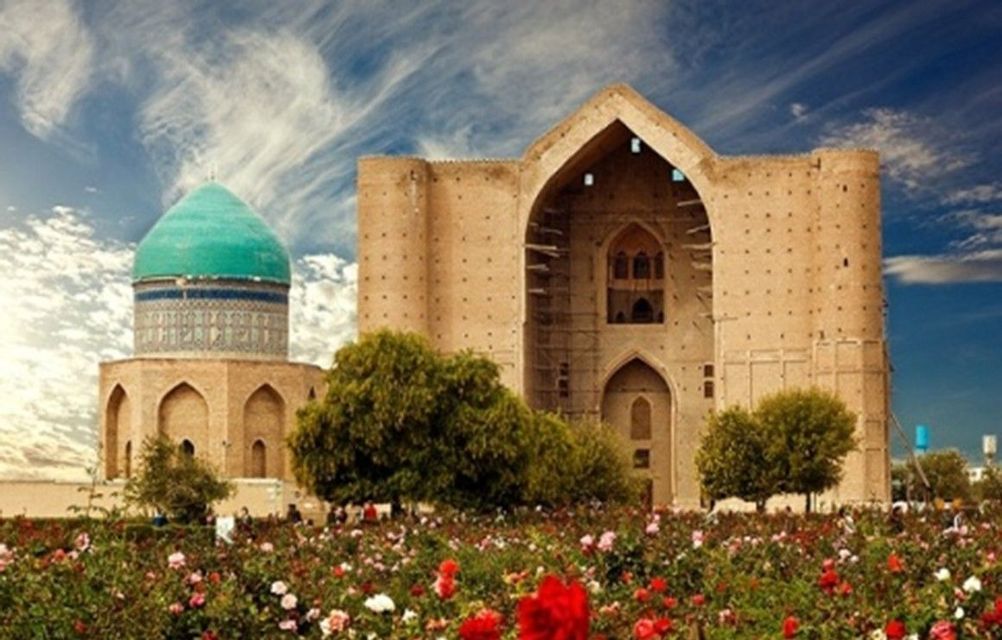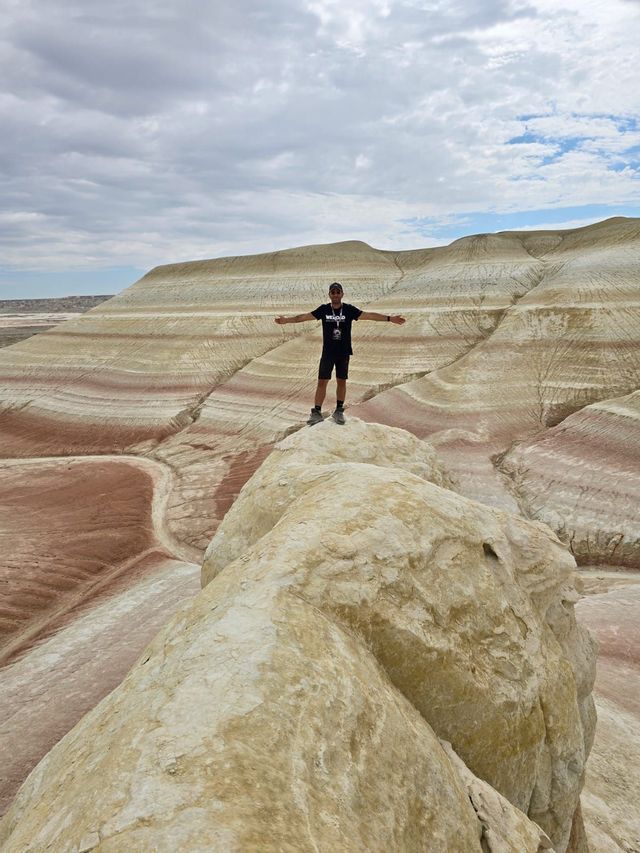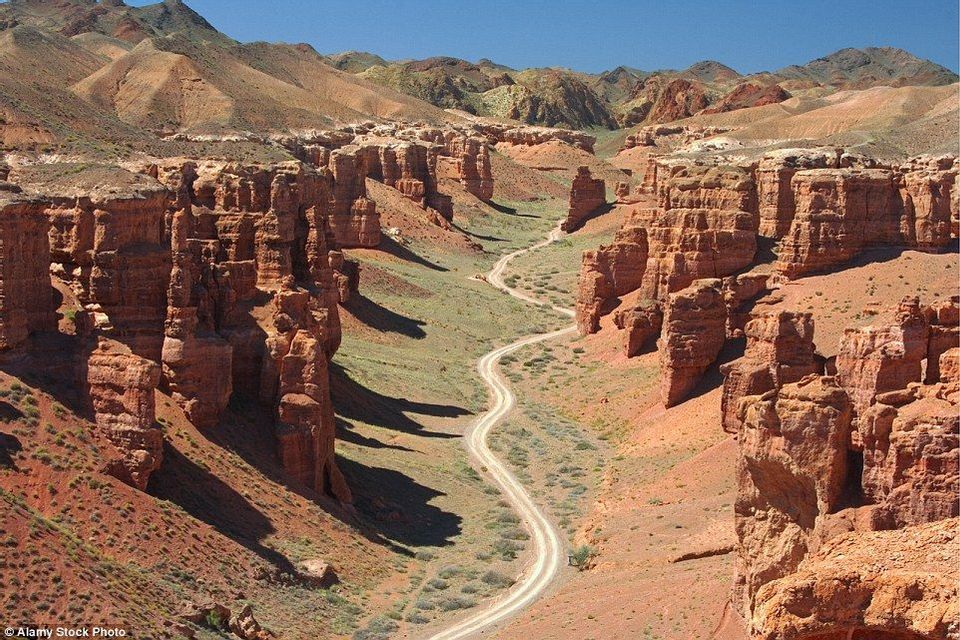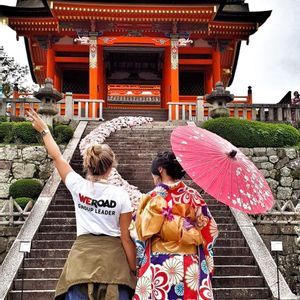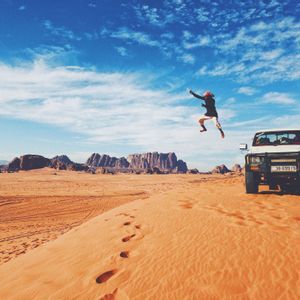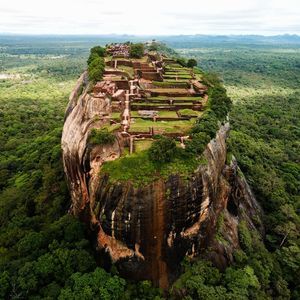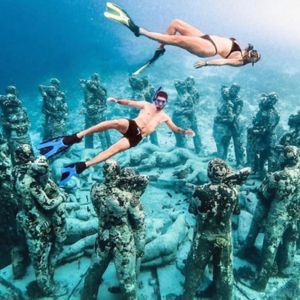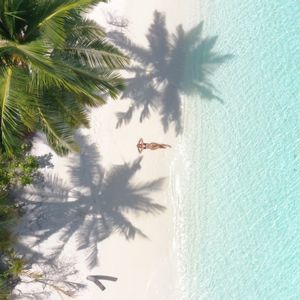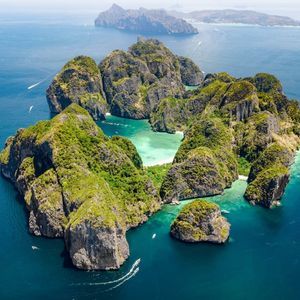Kazakhstan 360°: Almaty, Turkestan and the Mangystau Desert in 4x4
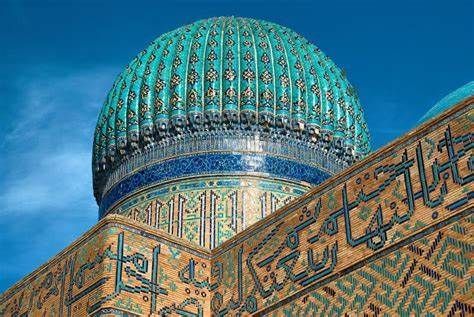
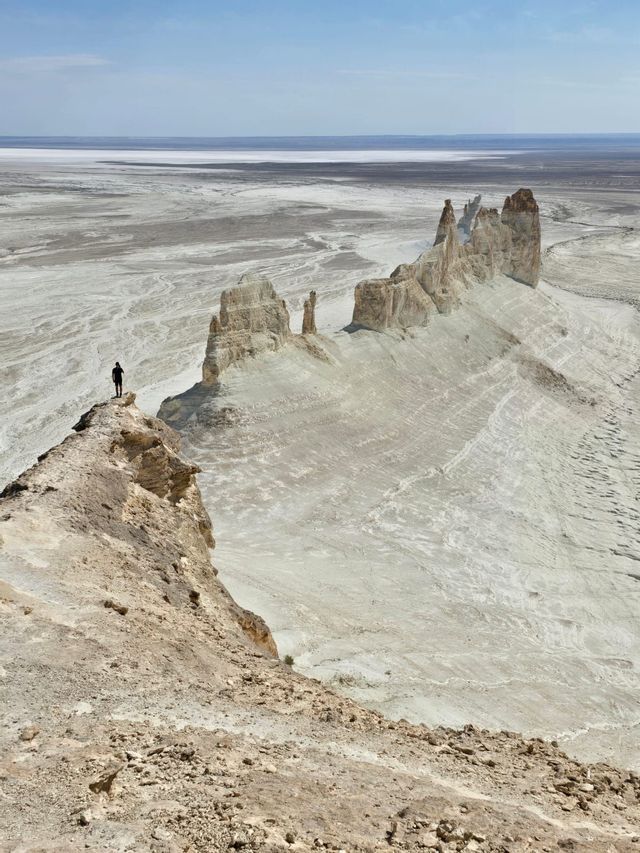
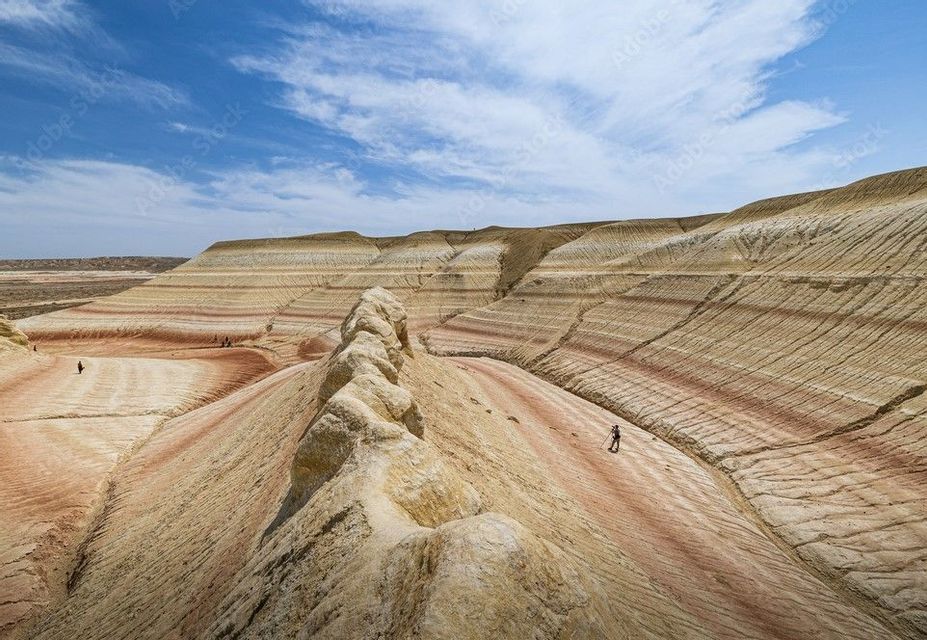
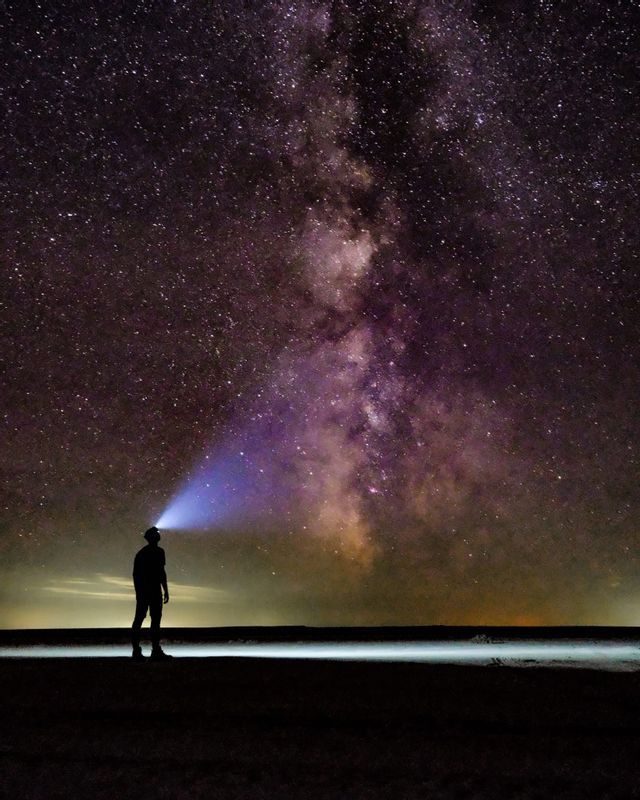
This is a WeRoadX
A trip designed and created entirely by an experienced WeRoad Travel Coordinator.
This is a trip designed and created entirely by an experienced WeRoad Travel Coordinator. They organise the whole trip: from defining the itinerary to selecting accommodation and on-site experiences. On the WeRoad website you can book the trip and manage it in MyWeRoad, just like any other WeRoad.
Group info
Expected WeRoaders: 8
Itinerary
From the dramatic peaks of the Tien Shan to the surreal deserts of Mangystau, Kazakhstan is a land of wild beauty and striking contrasts. Ancient Silk Road cities meet futuristic skylines, and deep-rooted nomadic traditions echo through vast, untouched landscapes.
We’ll hike through the otherworldly Charyn Canyon, explore alpine lakes hidden in mountain forests, and ride a night train to the historical heart of Turkestan. Then, we’ll go off-road in Mangystau—one of the most remote regions in the world—where chalk canyons, salt mirrors, and the colorful “Tiramisu Hills” create a setting that feels more Mars than Earth.
This is Kazakhstan like you’ve never seen it—raw, rugged, and utterly unforgettable.
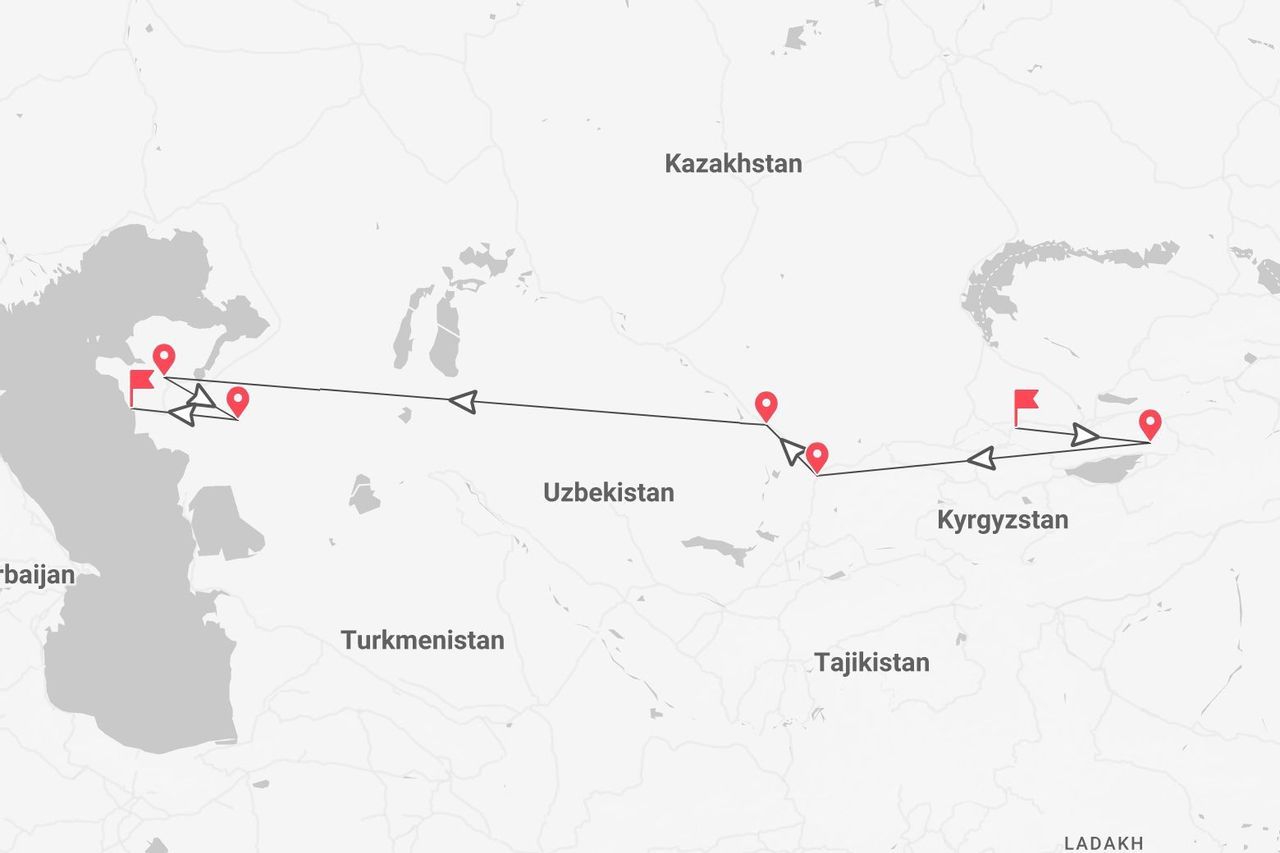
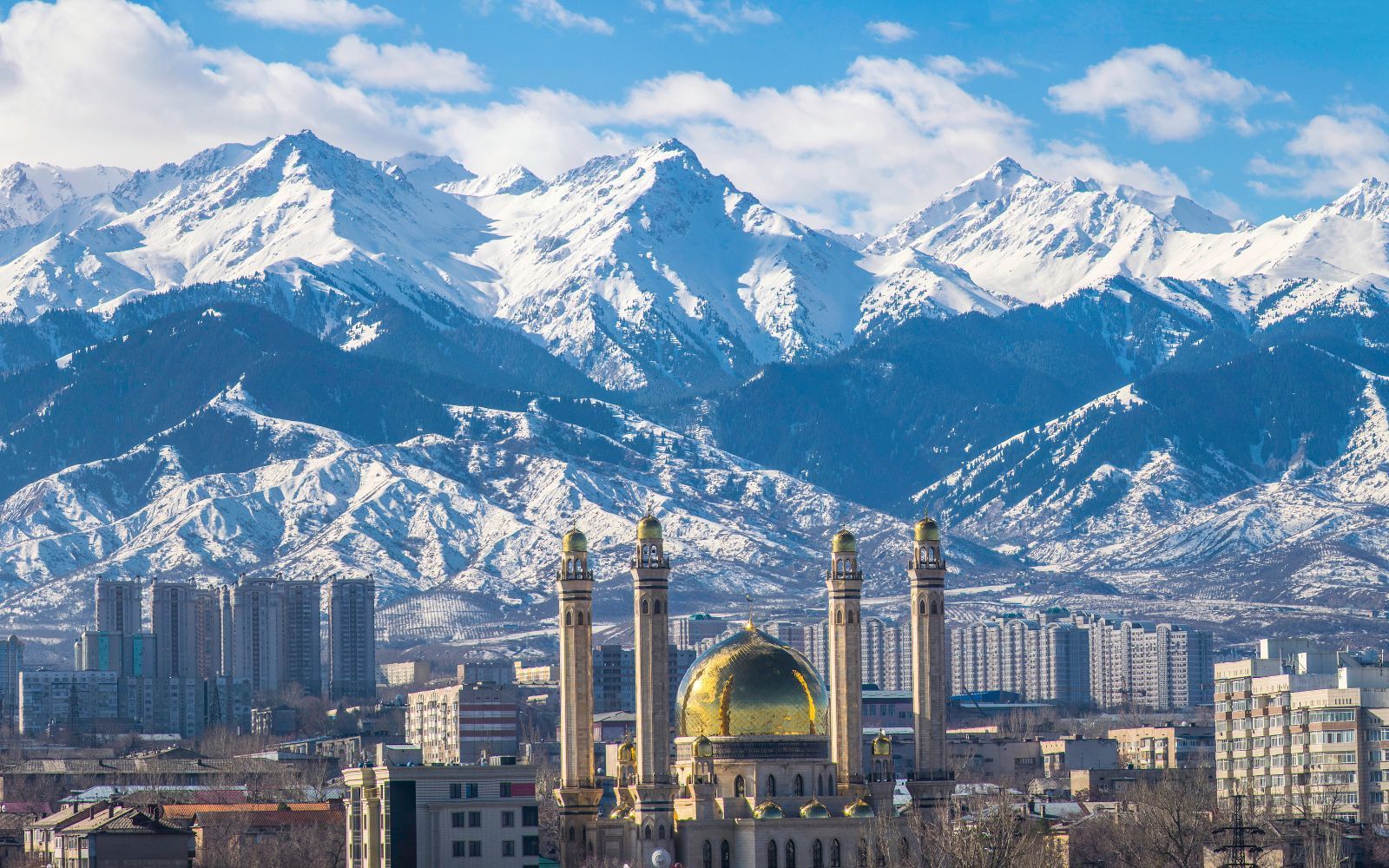
Welcome to Kazakhstan!
Check-in: Our adventure begins in Almaty
Our adventure begins in the most populous city and, until 1977, the capital of Kazakhstan. We immerse ourselves in the local culture with a tour that touches the symbolic places: the Ascension Cathedral , completed in 1907, with its 56 meters, it is the second tallest wooden building in the world and the only building in Almaty that remained intact following the devastating earthquake of 1911. Then we'll visit the Park of the 28 Panfilov Guards, the Republic Square and the Museum of National Musical Instruments . Over 1000 objects are featured in the museum's collection, including rare finds dating back to the 17th century.
Later we'll make our must-visit to the Green Bazaar , the oldest and largest market in Kazakhstan where you can find and try local products of the country, such as fresh camel milk. At sunset we take a cable car up the Kok Tobe hill to admire the city from above and the majestic mountains that frame it before tasting local dishes at dinner in a local restaurant.
From Charyn Canyon to Kolsay Lakes
Charyn Canyon and the Kosay Lakes
This morning we will meet the local guide and the driver who will accompany us for the next three days to discover the eastern part of this region. We load our backpacks on the van and off we go in the direction of Charyn Canyon !
This place is a unique natural complex not only in Kazakhstan, but in the whole world. Formed in the Paleogene era, steep slopes of the canyon reach 150-300 m and you're also surrounded by towers of rocks made by wind and water, also known as Valley of Castles.
We'll make our way to Kolsay Lakes State Natural Park. Kolsay Lakes are a system of three lakes called “pearls” of the Northern Tien Shan. The lakes are surrounded by coniferous forests of spruce. We take the opportunity to take a nice walk along the Lower Lake and if we have time we could reach the Central Lake which is located at 2250 m above sea level.
Late in the evening we reach the village of Saty and the guesthouse where our first family dinner awaits us.
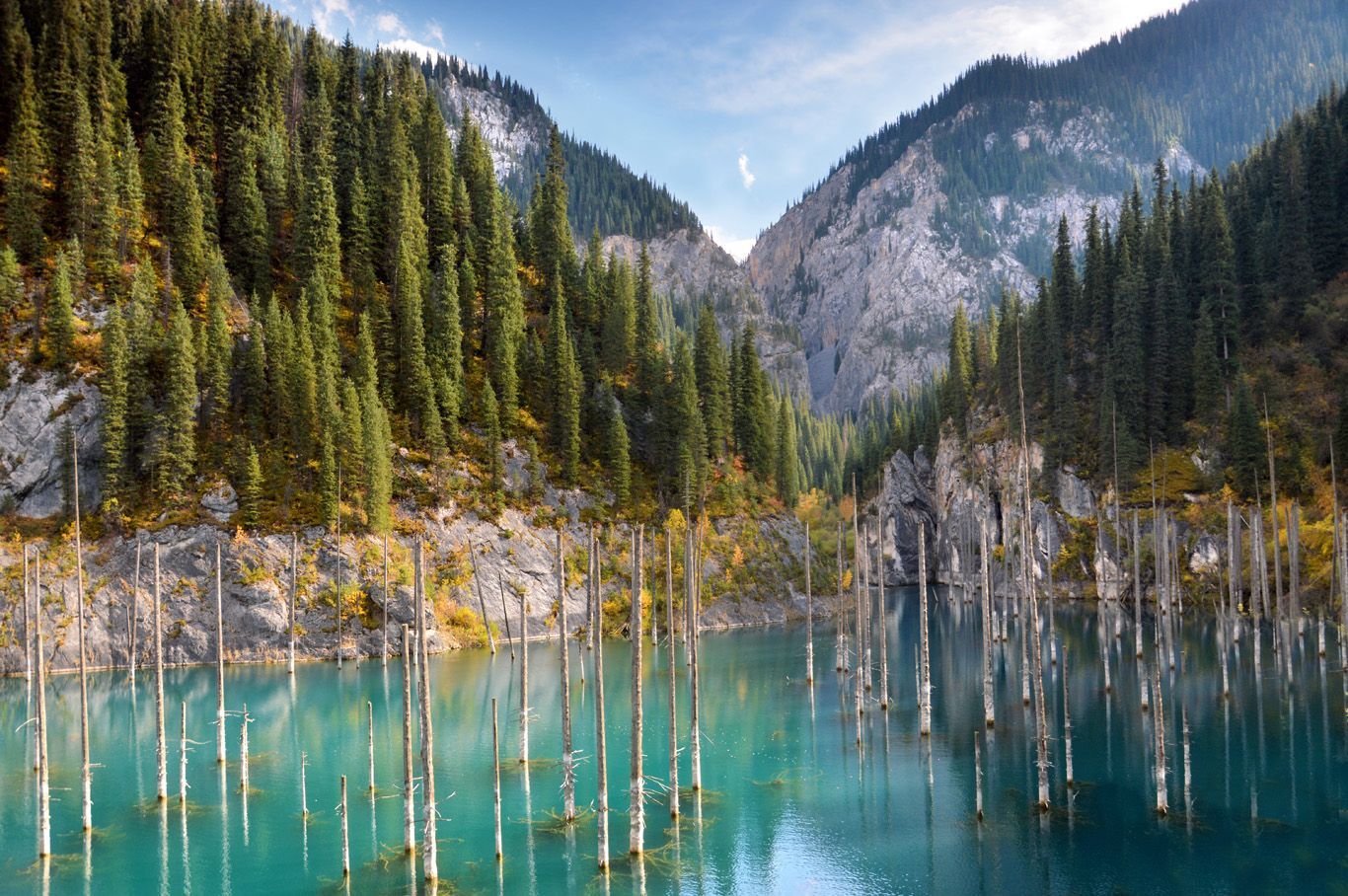
The “submerged forest” of Kandy Lake
The mysterious Kandy Lake
We'll visit a lake nestled at 2,000 meters above sea level, reaching depths of up to 30 meters. It was formed in 1911 after a powerful earthquake (7.7 on the Richter scale) triggered a massive limestone landslide, creating a natural dam. This dramatic event reshaped the landscape and gave birth to a stunning rain-fed lake, known for its crystal-clear waters in countless shades and its icy temperature.
What makes this place truly extraordinary is the submerged forest of Asian Red Fir trees. Their bare trunks rise eerily above the water’s surface, while the branches and leaves remain perfectly preserved below—frozen in time since that fateful day in 1911.
This is a one-of-a-kind natural wonder that draws divers from around the world, eager to witness the surreal underwater forest. Weather permitting, we may also enjoy a horseback ride through the surrounding area, taking in the rich flora and fauna that make this place so special.
After lunch, we’ll return to Almaty and board the night train to Shymkent, continuing our journey along the historic Silk Road.
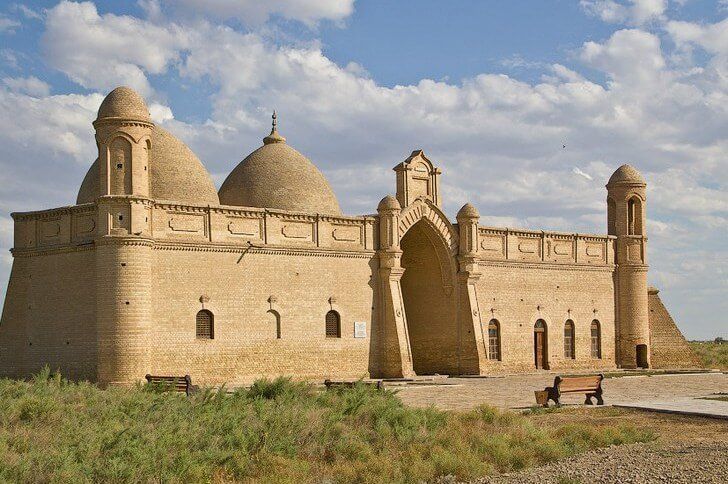
Turkestan, the wonders of the Silk Road
Welcome to Shymkent
A local guide will introduce us to this thousand-year-old history with our tour around Shymkent, the second most populous city in Kazakhstan and is a place where past and present coexist in harmony.
We'll explore the city that was founded in the 12th century as a " caravanserai " to protect the city of Sayram on the Silk Road and grew as a market centre for trade between Turkic nomads. We'll learn how, over the years, first Islamic architecture and then 19th-century Soviet architecture have transformed the city.
The ancient city of Otrar and the mausoleum of Arystan Bab
Our journey through Turkestan continues through the ruins of Otrar , an ancient settlement destroyed by the Mongol invasions of Genghis Khan in 1219. Excavations begun in 1969 have brought to light the remains of numerous brick structures, including a palace, mosques, a bathhouse and ovens.
Before arriving in the city of Turkestan, we make a stop at the mausoleum of Arystan Bab .
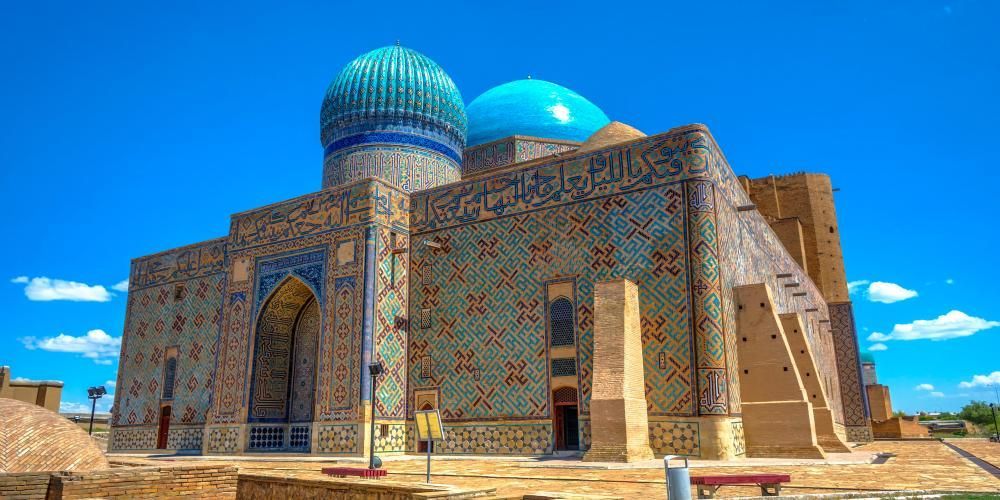
The Turquoise Domes of Turkestan
Turkestan city
Our journey takes us to Turkestan, once a thriving seat of power during the late Middle Ages. It served as a residence for Timurid and later Shaybanid rulers, and was later chosen by the Kazakh Khans as their capital and the spiritual heart of their lands.
As we explore the city, we'll get a sense of its past as a major crossroads for traders and travellers from all over the region. One of the highlights of our visit will be the Mausoleum of Hodja Ahmed Yasawi — Kazakhstan’s first UNESCO World Heritage site, recognised in 2002. This grand monument honors the revered Turkish Sufi poet and mystic who played a key role in shaping Sufi traditions across the Turkic-speaking world.
In the afternoon, we’ll return to Shymkent and catch a domestic flight to Aktau, arriving in the evening — ready for the next leg of our adventure.
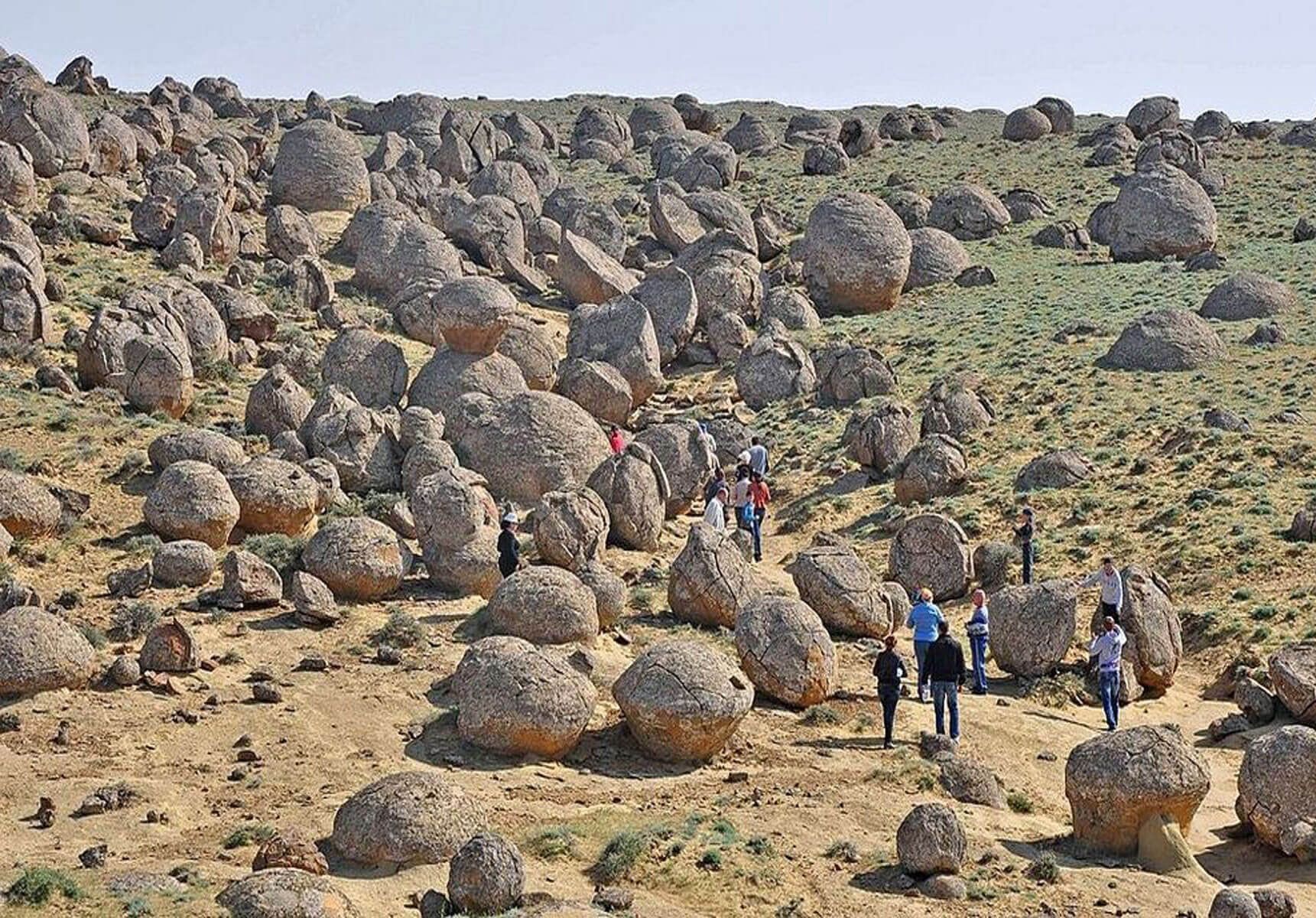
On the road to discover the magnificent Mangystau
4x4 Adventure
We climb into our jeeps towards Zhygylgan , a huge crescent-shaped cliff, which scientists say was formed a million years ago as a result of a meteorite shower. At the base you can see traces of herbivorous and predatory animals from the Triassic period (millions of years ago): saber-toothed tigers, lions, the ancestors of today's horses inhabited this area.
Then, we continue towards the picturesque Kapansay , a narrow chalk canyon, which impresses with its sheer and uniform walls, which reach a height of 70 meters.
We will then stop at the Shakpak-Ata underground mosque to discover the UNESCO heritage site dating back more than 1000 years.
Torysh, valley of stone spheres
After lunch, we head to Torysh , a large barren expanse occupied by hundreds of mysterious spherical rock formations. These stone balls have a size of about 3-4 m in diameter. The time of formation began 180-120 million years ago.
A local legend says that swarms of invaders came like locusts to Mangystau. The locals raised their hands to the sky to pray for help and were heard. The heavens opened with storms, thunder and lightning. In an instant the enemies turned to stone. Luckily, we escape this legend and arrive at the ethnic village of Kogez for an overnight stay in traditional Kazakh yurts.
Between salt deserts and starry skies
Mount Sherkala and Tuzbair
We're back on the road to the the multi-coloured mountain of Sherkala . From a certain angle, it looks like a giant yurt. Our journey continues to the vast Ustyurt plateau, where nature has created another miracle: the magnificent Tuzbair salt lake. First we admire it from above and then we will descend for a walk along the salt flats. During heavy rains or melting snow, the salt marsh fills with water and turns into a huge salt mirror that reflects the sky.
The chalk cliffs are carved and riddled with deep channels that form countless chains of fantastic columns. At the end of the lake there is a giant natural semi-arch created by the wind, the Tuzbair Arch . At sunset we reach the tented camp. We will spend the night in a tent surrounded by a starry sky. Dinner prepared on the fire in the camping area.
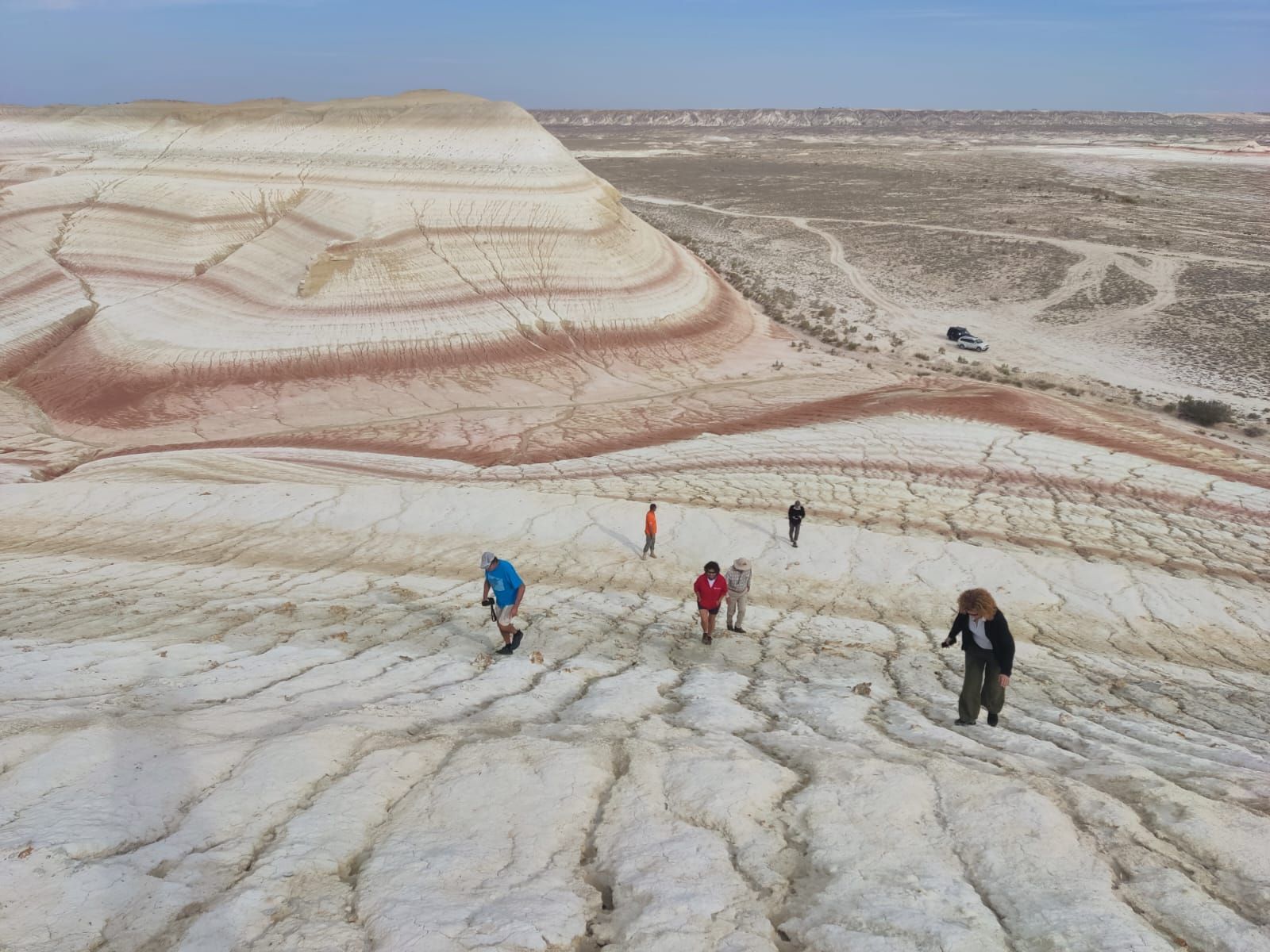
Boszhira Valley and Tiramisu Hills
La Monument Valley Kazaka
On this last day on the road we drive to a place of extraordinary beauty: the Boszhira Valley . where mother nature has given complete freedom to her imagination, creating an otherworldly landscape in shades of white - canyons, peaks, mountains-towers, mountains-castles, mountains-yurts. Among these rock formations rises the Bokty Mountain , a colourful striped mountain nestled in the desert, which is so iconic that it's depicted on the 1000 tenge banknotes of the local currency.
The colours of the mountains Tiramisu
Today we will have a picnic lunch in a unique place in the world, at the foot of the Kyzylkup Hills, better known as Tiramisu Hills !
These hills are reminiscent of a tiramisu because of the bizarre horizontal stripes of pale pink, burgundy, gray and white rock. An easy climb will allow us to take some crazy photos of this incredible place still little known to mass tourism.
On the way back to Aktau we cross the Karagie Depression, the fifth deepest in the world with a depth of 132 meters below sea level. Here we reach a great viewpoint: the Sautty tract cliff. Its name translated from the Kazakh language as "black cavity".
We return to the civilisation of Aktau . After checking in, we'll head out for our final Kazakh group dinner!
Goodbye Kazakhstan!
Check-out and goodbyes
It's time to say goodbye, but if the flights are late in the evening (yes, it's an invitation to take them as late as possible) we still have a chance to visit the city of Aktau together.
What's included
5 nights in a hotel in a double or triple room with private bathroom and 1 night in a guesthouse
1 night in a yurt in a local Ethno Village
1 night in a tent in Mangystau desert
All breakfasts from day 2 to day 10 (excluding breakfast on the night train on day 5)
Private minivan rental with driver from day 2 to day 5
Medical and baggage insurance - (coverage limits by destination country/region - €10,000 Italy, €20,000 Europe, €30,000 World, €50,000 USA/Canada)
What's not included
Roundtrip flight to/from destination
Meals and drinks unless specified
Any souvenirs you would like to bring back home with you :)
- Anything not mentioned in the "What's included" section
Money pot
The amount to be paid to the coordinator will be approximately 180 euros. The common fund is used to cover extra activities that the whole group wants to participate in, in addition to the services mentioned here; for this reason the amount may vary and it may be necessary to implement it further, in any case the unused difference will be returned.
Any transportation in the city of Almaty and Aktau
The activities and extras that all participants have agreed to do and the relative share of the coordinator
Tips for all local service providers who will help make our journey unique. In this country everyone expects it, because, unlike Italian customs, the tip is a significant part of their salary and as responsible travellers we believe it is appropriate to reward the services received by adapting to local standards and culture.
Additional info
Private rooms are available for this trip
- Private Room Option Show all details
Why WeRoad
-
Small groups, on average 11 people
-
Free cancellation included (deposit refunded as a gift card)
-
Book with a £/€100 deposit
Find your flight
For this trip, we recommend arriving and departing from these airports.
FAQs – Frequently Asked Questions
About this trip
This trip starts at Almaty. On the first day, we meet at 18:00.
This trip ends at Aktau. On the last day, you are free to leave anytime from the morning onward, so you can arrange your flights as you prefer!
In this trip there will be many excursions that will allow us to fully appreciate the beauty of the destination, but none of them require particular physical preparation.
For this itinerary, traveling with a backpack is mandatory for logistical reasons and the convenience of the entire group - including yourself! Trolleys, bulky suitcases, or hard luggage are not allowed. The Travel Coordinator will provide guidance on the ideal baggage before departure via the WhatsApp group.
About Kazakhstan
If you are a UK citizen, to find out the entry requirements for Kazakhstan, you can check this informational page from our partner Sherpa. If you need a visa, you can apply for it through Sherpa. If you are not a UK citizen, you can still use Sherpa by changing the nationality in the 'Passport' section.
Before traveling, always remember to check the government website of your country of origin for updates on the entry requirements for Kazakhstan – you wouldn’t want to stay home due to a bureaucratic detail!
- UK residents: review the FCDO Travel Advice.
- US residents: consult the US Department of State Travel Advice.
- Other residents: refer to your government or local consulate's travel advice.
Kazakhstan spans across two time zones: East Kazakhstan Time (GMT+6) and West Kazakhstan Time (GMT+5).
- If it is 12pm in the UK, it will be 6pm in East Kazakhstan and 5pm in West Kazakhstan.
- If it is 12pm in New York, USA, it will be 10pm in East Kazakhstan and 9pm in West Kazakhstan.
Kazakhstan doesn't observe daylight saving time, so these time differences remain constant throughout the year.
Kazakhstan uses the Kazakhstani Tenge (KZT) as its currency. The daily exchange rate is approximately:
- 1 GBP to 590 KZT
- 1 USD to 470 KZT
- 1 EUR to 510 KZT
You can exchange currency at banks, official exchange offices, and some hotels. Make sure to check rates as they can vary slightly between providers.
Payment methods in Kazakhstan include cash, credit cards, and mobile payments.
- Credit cards like Visa and Mastercard are widely accepted in cities and larger towns, but it's a good idea to carry some cash for smaller shops or rural areas.
- Mobile payment options like Apple Pay and Google Pay are becoming increasingly popular, especially in urban areas.
Having a mix of payment options will ensure you're prepared for any situation.
Tipping in Kazakhstan is appreciated but not mandatory. In restaurants, you can leave around 10 percent of the bill as a tip if you are happy with the service. For taxi drivers and hotel staff, rounding up the fare or bill is a nice gesture. It's always good to carry some local currency for tipping, as not everyone accepts credit card tips.
In Kazakhstan, internet access is generally good in urban areas, but coverage can be spotty in rural regions. Wi-Fi is widely available in hotels, cafes, and shopping centers in cities. However, for more reliable connectivity, especially if you're traveling around, we suggest you buy a local SIM card or an e-SIM data plan. Popular providers include:
- Beeline
- Kcell
- Tele2
These offer various data packages that can suit your needs. Just make sure your phone is unlocked to use a local SIM.
In Kazakhstan, people mainly speak Kazakh and Russian. Kazakh is the state language, while Russian is commonly used in business and everyday communication. Here are some useful expressions you might hear or use:
- Hello: Salam (Kazakh), Privet (Russian)
- Thank you: Rakhmet (Kazakh), Spasibo (Russian)
- Yes: Iya (Kazakh), Da (Russian)
- No: Zhok (Kazakh), Nyet (Russian)
- Please: Otinish (Kazakh), Pozhaluysta (Russian)
Kazakhstan uses Type C and Type F plugs, which are the same as those used in most of Europe. The voltage is 220V, and the frequency is 50Hz. If your devices are from the UK, the USA, or other countries with different plug types, we recommend you bring a universal adapter to ensure compatibility with Kazakhstani sockets. Always check your device's voltage compatibility to avoid any issues.
In Kazakhstan, the main religion is Islam, with a significant portion of the population being Muslim. It's important to note that Kazakhstan is a secular country, so religious practices can vary widely. However, if you're visiting, it's respectful to dress modestly, especially in religious sites. Women might consider wearing clothing that covers their shoulders and knees. Important religious holidays include Eid al-Fitr and Eid al-Adha, which are celebrated widely across the country.
Kazakhstan offers a variety of climates, so packing smartly is key. Here's a helpful list for your backpack:
-
Clothing:
- Lightweight shirts and trousers for summer
- Warm layers for winter, like a down jacket
- A raincoat or umbrella
- Swimwear if visiting the Caspian Sea
-
Shoes:
- Comfortable walking shoes
- Sandals for warmer days
- Waterproof boots for winter
-
Accessories and Technology:
- Sunglasses and a hat
- Portable charger
- Travel adapter (Kazakhstan uses Type C and F plugs)
- Camera or smartphone for photos
-
Toiletries and Medication:
- Basic toiletries like toothbrush, toothpaste, and deodorant
- Sunscreen and lip balm
- Common travel medications like pain relievers and anti-diarrheal pills
Kazakhstan experiences a wide range of weather conditions due to its large size and diverse geography. Here’s a general idea of what to expect:
- Northern Kazakhstan: Cold winters and warm summers. Winters can drop to -20°C (-4°F), while summers reach around 30°C (86°F).
- Southern Kazakhstan: Mild winters and hot summers. Winter temperatures can be around 0°C (32°F), and summers can soar to 40°C (104°F).
- Best time to visit: Spring (April to June) and autumn (September to October) offer comfortable temperatures and pleasant weather throughout the country.
About WeRoad
Round-trip flights are not included in any of our trips because we like to give you autonomy and flexibility: you can choose the airline you want to fly with, the departure airport that suits you best, and how many and which stops you want to make.
Since flights are not included, you also have more flexibility with your travel dates: if possible, you can arrive at your destination a few days earlier or return home a bit later – or even continue independently to a nearby destination!
This is the question of all questions, and here’s the answer, broken down into points!
The Money Pot is a common fund collected in local currency from all tour participants and managed by your Travel Coordinator.
It is used to streamline paymentsfor extra activities, goods and services that the whole group decides to do and to guarantee flexibility in choosing activities and excursions at the destination in line with the mood of the group.
It is typically collected on the first day of the trip in local currency, although at times, the Travel Coordinator may ask for it to be paid before departure.
You’ll find the amount of the money pot on the website under the section ‘What’s included in the money pot’ – how do you get there? Look for ‘What’s included’, scroll down to ‘Money pot? Click here’, and you’ll find the details.
The amount varies depending on the destination chosen.
It is used exclusively for group expenses that ALL participants decide to take part in.
It is estimated based on the experiences of other groups but can vary depending on the needs of the group itself. As such, the Travel Coordinator may need to increase the amount during the trip.
If not all of the money pot is used, the difference will be returned to all participants at the end of the trip in equal amounts.
The Money Pot also covers the Travel Coordinator’s share of the activities included in the money pot, except for those activities that are free for the Travel Coordinator.
If you pay in advance part of the money pot before the trip for certain non-refundable optional activities, unfortunately, the amount cannot be refunded in case of trip cancellation.
We offer several payment methods to fit every need:
1. Credit or prepaid card (Visa, Mastercard, American Express);
2. Instalment payment with Scalapay up to €4,999 (only available with the “Full trip payment” option – not available with the “Deposit and balance” option; pay in 3 instalments up to €1,200 or in 4 instalments over €1,200);
3. PayPal (for selected destinations);
4. Revolut Pay to pay even faster straight from your Revolut account;
5. Welfare credit – BEFORE BOOKING, reach out to us at [email protected].
If you choose the deposit and balance option, you’ll also be able to pay the balance via bank transfer from your Personal Area.
Anyone who books a WeRoad trip has the option to cancel or modify the trip – including both the dates and the destination – free of charge up to 31 days before departure. In case of cancellation, you will receive a 100% refund of the WeRoad trip price. (Deposits will be refunded in the form of a gift card valid for 365 days from issue date.) If you make a change, a price adjustment will be applied to the new trip chosen – meaning, if the new trip is cheaper, we will refund the difference; if it’s more expensive, you will need to pay the difference.
If you’ve purchased the Flexible Cancellation Option (which you can add in the first step of the booking process), you can request a cancellation or trip change until 8 days before departure. In case of cancellation, you’ll receive a 100% refund of the WeRoad trip price, minus the cost of the Flexible Cancellation option. Deposits will be refunded in the form of a gift card valid for 365 days from issue date.
How to request a cancellation or change to your trip? Send us an email at [email protected] or a WhatsApp on +447716573700. Please share the booking reference for the trip you want to cancel or change, and, in case of a change, the new trip you would like to join.
In general, we always choose local accommodations, avoiding large hotel chains, because we love to experience the culture of the place and, whenever possible, contribute to the local economy. Typically, our accommodations are hotels, apartments, guesthouses, and hostels run by local entrepreneurs, with the same standard maintained across all trips in the same destination.
For our Collection trips, which are our premium category, the accommodations are always 4 or 5-star or carefully selected boutique hotels.
The list of accommodations for your trip will be shared with you by your Travel Coordinator between 5 and 3 days before departure, along with other useful details for your adventure!
If you're wondering why WeRoad trips have a money pot, we’re assuming you already know what it is. If not, or if you have any doubts, we invite you to read all the information here!
Let’s quickly recap: The Money Pot is a common fund collected in local currency from all tour participants and managed by your Travel Coordinator. It’s used to speed up payments for extra activities, goods and services that the whole group decides to do and to guarantee flexibility in choosing activities and excursions at the destination in line with the mood of the group.
But let’s get to the point: why the money pot? First of all: it gives us a lot of flexibility. In all WeRoad trips you will have a bunch of Must See/Must Do activities already included - these are experiences, places or activities that simply cannot be missed! Any extra activities is decided by the group, why? Because each group is unique and may have particular wants or desires and the Money Pot allows each group to customise their trip to make it perfect for their requirements!
It also helps us speed up payments – imagine being in the subway in New York City, one by one purchasing the ticket...a nightmare right? Thanks to the Money Pot, the Travel Coordinator can simply purchase the tickets for everyone making the entire processes smoother! Any leftover money will be returned at the end of the trip and split equally amongst all participants.
In some destinations, buying goods or services on site is more economical as you are able to negotiate the price - places like Morocco, or South East Asia, bargaining is part of the culture. As such, our Travel Coordinators will be able to secure the best deal for all participants.
The amount of the money pot is specified in each trip – look for this button
which will take you to a detailed breakdown for each trip, like this:
Even if we don't know the flights of all WeRoaders, there are several ways to find out which flights your travel companions have purchased.
1. Each WeRoader has the ability to communicate their flight details after booking within their personal area so that other travel companions can see the details anonymously. Enter your booking and you will find this section:
[Screenshot]
2. If you want to find out before booking, instead, you can contact us and we will support you in your search or you can ask your travel companions for direct information by joining our Facebook group 'WeRoad... let's get to know each other before leaving! (official)' – (here is the extended link: https://www.facebook.com/groups/weroadit) look for a post associated with your trip, or ask the group administrators for help in getting in touch with your future adventure companions!
If the coordinator has already been assigned to the trip you are interested in, you can easily find his/her presentation post in the group through the site: in the shift list click on 'Ask the coordinator', or in the trip tab, in the coordinator section, click on 'Ask [coordinator name] about this shift in our Facebook group'. For both cases, see the screenshots below!
[screenshot]
On our group trips, the Travel Coordinator and participants speak English – knowing how to speak and understand English is therefore a fundamental requirement to participate in WeRoad.com trips.
On average, groups consist of 12 people, with a minimum of 3-4 participants and a maximum of 18-20 in exceptional cases.
The average age varies depending on the age range indicated for each trip: for 25-35 year-olds, it's usually in their 30s, and for 35+ year-olds, it's around 40. However, if you'd like to know the average age of a group, contact us via WhatsApp at 3484231163.
Regarding the gender mix, there's no guarantee that the group will be balanced, as it all depends on you and on when and what you book! We can, however, reveal a detail: many women book well in advance, while many men often arrive a bit last minute!
Want to know the specific composition of your group? Find out how here.
Yes! If you're curious, you can take a sneak peek at the group before booking – although, in our opinion, that kind of spoils the surprise! You’ll find the info in the ‘Group’ section for each trip on the departures page, showing how many WeRoaders have already booked. Click the little arrow and you’ll even see their gender and ages – but hey, that’s exclusive info, so we’ll ask you to log in or sign up to see that!
The WeRoad Travel Coordinator is an experienced and skilled traveller and will be the perfect companion for your trip. They will be available for any eventuality and will manage all the logistical aspects of the itinerary (transports, timings, accommodations, meeting points, etc.), so you can enjoy the trip without any worries!
You will have the chance to get to know them when the WhatsApp group is created approximately 2 weeks before departure - this will be the moment to ask any pre-departure questions and get to know the rest of the group! If the trip you are interested in already has a Travel Coordinator assigned, you can contact them before booking – their details will be specified in the schedule or on the trip page, or you can search for their name here. After booking, you will find their contact details in your Personal Area, under ‘Bookings and Trips’ > ‘Your Upcoming Trips’ > ‘Trip Details’.
Yes, in all our trips you will share a room with other same-sex travellers, and the bathroom will either be private or shared only with fellow participants of the trip. The rooms we select can be doubles, triples, quadruples, or multi-bed (up to 8 people in exceptional cases), depending on the destination and availability.
There are never dorms with people outside the WeRoad group, except in certain cases for local experiences, which are specifically mentioned in the itinerary or communicated before booking. These typically involve specific nights in unique accommodations like tents, homestays, or camping, offering a more adventurous travel experience in exchange for some comfort.
During the booking process, you can also choose to opt for a mixed room: in this case, if needed, only those who have agreed to this option may share a room with travellers of a different sex. If you are booking for multiple people together and select this option, the room will not be exclusive to your group but may be shared with other travellers in the group.
When you set off on a WeRoad trip, you’re officially a WeRoader – and as we often say, 'Once a WeRoader, always a WeRoader'. This means that once you’re part of the community, a little piece of WeRoad will always stay with you, even if you no longer travel with us.
But you’re not just a WeRoader during your trips, far from it! The community is alive and active all year round: you can stay in touch by following and interacting on our social media channels, like the Facebook group or the Instagram profile. We can also meet up for a dinner or a trek together at one of the events organised by our coordinators around the world!

